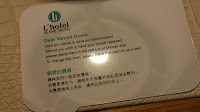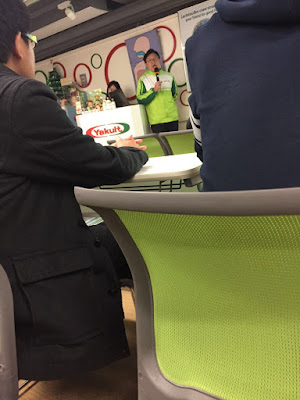About the L’hotel Group…
L’hotel
Management Company Limited or L’hotel Group, a member of Chinachem Group, is a
contemporary lifestyle hospitality group which comprises of the L’hotel and
Lodgewood series. The L’hotel Group endeavors to redefine the notions of
hospitality, comfort and style in Hong Kong with its affordably luxurious
hotels and modern chic fun-filled boutique hotels cum serviced apartments.
L’hotel accounts for four upscale hotels spread throughout Hong Kong. All of
the hotels offer an unwavering level of modern Asian hospitality, house
exceptional facilities including swimming pools and fitness centers and feature
high quality restaurants and trendy bars for guests and visitors alike.
About L’Hotel Island South...
-> Have a look at the official introductory video first! <-
Located 15 minutes’ drive away from Causeway Bay shopping area with close proximity to Ocean Park and Aberdeen Marina Club, L’hotel Island South, Hong Kong’s first Geopark Hotel, brings guests to the quaint Southern District on Hong Kong Island, where the richness of nature serves as stunning backdrop to the Hotel’s contemporary ocean inspired interior design. This 432-room stylish hotel is a relaxing urban oasis, ideal for both business and leisure travelers to take a break from hectic schedules. The Hotel also has a restaurant, a bar lounge, 3 function rooms, an outdoor swimming pool and a gym.
Design concept
L’hotel
Island South embraces an aqua theme from its natural surrounding environment.
The ocean and seafood play a significant role in this part of Hong Kong Island
with the area able to trace its roots back to its fishing town days and boasts
the Jumbo Floating Restaurant as a renowned attraction. The Hotel’s exterior
imitates water ripples with the water element continuing to trickle through to
every aspect of design and décor throughout the premises. All the art pieces in
the Hotel and rooms are environmental friendly and linked to nature, conveying
a sense of the area and what it used to be. Team members are exquisitely
outfitted in clothing exclusively designed by internationally renowned designer
Dorian Ho.
Awards in 2014-201
2015
Luxury Green Hotel Country Winner (Hong Kong) - World Luxury Hotel
Awards
2015 Lis Café and Bar LIS: Quality Tourism Services
Scheme – accredited restaurants - Hong Kong Tourism Board
2014 Manpower Developer Accredited Organization - Employees
Retraining Board
2014 A “Caring Company” - The Hong
Kong Council of Social Service
2014 “Partner Employer”
Award Outstanding Corporation - The Hong Kong General Chamber of Small and
Medium Business
2014 Luxury Serviced Apartments Country
Winner (Hong Kong) - World Luxury Hotel Awards
->
See more information from L’HOTEL ISLAND SOUTH FACTSHEET <-
------------------------------------------------------------------------------------------------------------------------------------
Our Visit to L'Hotel Island South...
 |
| Electronic Screen showing today's events @ Lobby |
 |
| Guest eKiosk @ Lobby |
 |
| Showcase of rocks to promote Eco-tour at HK @ Lobby |
 |
| Front office @ Lobby |
 |
| Info. corner about the HK Global Geopark of China @ Lobby |
 |
| Electric Car Charger, Carpark space, Hotel to airport limousine transfer service @ Podium Level 4 |
 |
| Bar LIS @ Podium Level 3 |
 |
| LIS Café @ Podium Level 3 |
 |
| Art work: "Butterflies" @ guest floor |
 |
| TV with customized label of "L'hotel" @ Grand Aqua Suite |
 |
| Private balcony with stunning view @ Grand Aqua Suite |
 |
| Environmental friendly card for guests @ All hotel rooms |
------------------------------------------------------------------------------------------------------------------------------------
Questions & Answers
1. How many rooms can be made up on
average per day? How long does it take to prepare a standard guest room on
average?
Each room attendant is responsible for 14-18 rooms per day, usually 16. It takes around half an hour to prepare a standard guest room, however, it depends on the attendant’s experience and the room condition. It takes a longer time for preparing the check-out rooms while it takes a shorter time for preparing a room of over-night customers. The experienced room attendants will have well time management to finish preparing all rooms required in order to get off work on time ;D
Each room attendant is responsible for 14-18 rooms per day, usually 16. It takes around half an hour to prepare a standard guest room, however, it depends on the attendant’s experience and the room condition. It takes a longer time for preparing the check-out rooms while it takes a shorter time for preparing a room of over-night customers. The experienced room attendants will have well time management to finish preparing all rooms required in order to get off work on time ;D
2. How can L‘hotel differentiate
itself from other hotels of similar positioning in terms of operations, service
offerings and the number of headcounts?
The hotel targets customers who travel for leisure purpose. The hotel’s rooms are generally more spacious than those hotels in the hub of city. In terms of price, the hotel emphasizes “Affordable luxury” to customers, although it is a bit expensive, but it is affordable to most of the customers. Customers can enjoy luxury services and facilities at an affordable price.
The hotel targets customers who travel for leisure purpose. The hotel’s rooms are generally more spacious than those hotels in the hub of city. In terms of price, the hotel emphasizes “Affordable luxury” to customers, although it is a bit expensive, but it is affordable to most of the customers. Customers can enjoy luxury services and facilities at an affordable price.
3. Does the rapid growth of the hotel
online booking platforms such as Agoda, Expedia pose challenges or
opportunities to your hotel? What would you do to deal with these
challenges or opportunities?
The hotel treat these online booking platforms as partners. Although these platforms charge the hotel for commission fee, at the same time they will help introducing and recommending the hotel to the customers. However, the commission fee is relatively high which causes a challenge to the hotel. In addition, the hotel should have its own marketing strategy to design the percentage of relying on different selling channels, the percentage of relying online selling platforms should not be too high as there is a risk that the selling platforms collapse or become not popular to customers one day.
The hotel treat these online booking platforms as partners. Although these platforms charge the hotel for commission fee, at the same time they will help introducing and recommending the hotel to the customers. However, the commission fee is relatively high which causes a challenge to the hotel. In addition, the hotel should have its own marketing strategy to design the percentage of relying on different selling channels, the percentage of relying online selling platforms should not be too high as there is a risk that the selling platforms collapse or become not popular to customers one day.
To
deal with the above challenges, the hotel offers unique packages to customers
who book directly from the hotel’s website. Moreover, the hotel provides higher
flexibility to the customers as they may easily cancel or make special
requirements of their room without any extra administration fee.
4. How do you position yourself since
there are many hotels in Hong Kong?
The
hotel focus on offering relax and leisure experiences to customers. Other than
the spacious rooms provided, the location of the hotel makes customers able to
enjoy a relatively slow pace of life in Hong Kong, compared to those hotels in
downtown.
5. Are there any additional charges
for the 24-hour medical assistance and baby-sitting service?
Some
families choose to have the baby-sitting service as the parents have their own
planned schedule and not convenience to bring their babies to go with.
Therefore, the hotel offers baby-sitting services at a price of $80/ hour, and
minimum charges for 4 hours. In terms of medical assistance, the hotel offers
24-hour medical assistance services, including calling ambulance in urgent
cases for free, referral of nearby clinics for fee, and on-call doctor service
to visit the customers directly which charges around $2000 for the doctor’s
consultation fee.
6. How many cars and drivers are
available to provide the hotel-airport limousine transfer service? Are they
outsourced? If there are over-booked, what is your solution?
Many
customers choose to take the shuttle bus provided by the hotel to the MTR’s
airport express station then to the airport. Like other hotels in Hong Kong,
the shuttle bus service is outsourced as it will be very expensive to operate
by the hotel itself.
7. What would you do to maintain your
business when facing the decreasing numbers of overnight staying tourists?
There
is around 5% long staying customers in this season. The customers usually stay
for a relatively short period of nights at the hotel (i.e. 2-3 nights). It is
because they mainly joined tour group which offers different hotels in the trip
or they would have tight schedule that will travel to Mainland or Macau right
after visiting Hong Kong for a few days.
8. What technologies do you adopt to
maintain the sustainability of the hotel?
The
hotel uses LED light bulbs in rooms. There is a motion sensor at every room’s
entrance to control the switch of some light bulbs. Moreover, it developed a
mobile application to provide useful information to the customers instead of
using printed materials. Also, the room attendants will only change
towels and linen base on cutomers’ request or base on conditions, so that it
saves electricity and water used to wash these materials.
9. Why does L’hotel join the
VIVVA membership scheme? How would L’hotel attract more people to
join the membership?
Customers
of the hotels who aged 18 or above, with valid credit card and email contact
address can join the membership. The number of return customers has increased
after launching the VIVVA membership scheme. It is because the hotel offers
special discount and gift vouchers to members, members can also earn points
(i.e. the VIVVA dollars) when they spend money at the hotel (earn 1 point when
spending $1), and they can use the earned points to get rewards from the hotels
under the L’hotel Group.
10. How do you manage the front office
staff schedule? Are there any potential problems / risks to hire part-time
staff?
The
Food and Beverage (F&B) department usually needs part-time staff as it
responsible for various services like in-house dining, room services, banquet
and event F&B services, the other departments like front office should have
enough regular staff to handle the hotel’s normal operations. The hotel hire
pat-time staff base on actual needs, it calculates the number of part-time
staff needed using ratios. And there is a system to manage the part-time staff
recording their work time, a monthly report will be generated from the system to
keep track on the revenue and labor cost ratio. The potential risks includes
the hotel may sometimes cannot hire enough labor, and the hotel may face the
sudden absence cases of the part-time staff.
------------------------------------------------------------------------------------------------------------------------------------
------------------------------------------------------------------------------------------------------------------------------------
!!
Reflection !!
L’hotel
Island south is very impressive to us! From the first step we entered the
hotel, we can smell nice perfume and see many art works. These give us a relax
feeling with visible enjoyment. One special thing about the hotel is the
promotion of Eco-tour in Hong Kong, which is quite different from other hotels.
This hotel provides comprehensive accommodation, food, entertainment and
Eco-tour services to customers. Moreover, their facilities are also attractive,
for example there is a gym officer in the gym room to provide gymnastic advice
for customers. We really enjoy this visit! Hope we can have more chances
to visit other hotels and learn their operations in the future!
------------------------------------------------------------------------------------------------------------------------------------
------------------------------------------------------------------------------------------------------------------------------------
Reference












